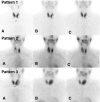Molecular imaging with (99m)Tc-MIBI and molecular testing for mutations in differentiating benign from malignant follicular neoplasm: a prospective comparison
- PMID: 26695504
- PMCID: PMC4844652
- DOI: 10.1007/s00259-015-3285-1
Molecular imaging with (99m)Tc-MIBI and molecular testing for mutations in differentiating benign from malignant follicular neoplasm: a prospective comparison
Abstract
Purpose: To compare mutation analysis of cytology specimens and (99m)Tc-MIBI thyroid scintigraphy for differentiating benign from malignant thyroid nodules in patients with a cytological reading of follicular neoplasm.
Methods: Patients ≥18 years of age with a solitary hypofunctioning thyroid nodule (≥10 mm), normal thyrotropin and calcitonin levels, and a cytological diagnosis of follicular neoplasm were prospectively enrolled. Mutation analysis and (99m)Tc-MIBI scintigraphy were performed and patients were subsequently operated on to confirm or exclude a malignant lesion. Mutations for KRAS, HRAS and NRAS and for BRAF and translocations of PAX8/PPARγ, RET/PTC1 and RET/PTC3 were investigated. Static thyroid scintigraphic images were acquired 10 and 60 min after intravenous injection of 200 MBq of (99m)Tc-MIBI and visually assessed. Additionally, the MIBI washout index was calculated using a semiquantitative method.
Results: In our series, 26 % of nodules with a follicular pattern on cytology were malignant with a prevalence of follicular carcinomas. (99m)Tc-MIBI scintigraphy was found to be significantly more accurate (positive likelihood ratio 4.56 for visual assessment and 12.35 for semiquantitative assessment) than mutation analysis (positive likelihood ratio 1.74). A negative (99m)Tc-MIBI scan reliably excluded malignancy.
Conclusion: In patients with a thyroid nodule cytologically diagnosed as a follicular proliferation, semiquantitative analysis of (99m)Tc-MIBI scintigraphy should be the preferred method for differentiating benign from malignant nodules. It is superior to molecular testing for the presence of differentiated thyroid cancer-associated mutations in fine-needle aspiration cytology sample material.
Keywords: 99mTc-MIBI; Fine-needle aspiration cytology; Follicular neoplasms; Molecular markers; Mutation analysis; Scintigraphy; Thyroid.
Figures
Similar articles
-
99mTc-MIBI Imaging in the presurgical characterization of thyroid follicular neoplasms: relationship to multidrug resistance protein expression.J Nucl Med. 2009 Nov;50(11):1785-93. doi: 10.2967/jnumed.109.064980. Epub 2009 Oct 16. J Nucl Med. 2009. PMID: 19837765 Clinical Trial.
-
(99m)Tc-Methoxy-Isobutyl-Isonitrile Scintigraphy Is a Useful Tool for Assessing the Risk of Malignancy in Thyroid Nodules with Indeterminate Fine-Needle Cytology.Thyroid. 2016 Aug;26(8):1101-9. doi: 10.1089/thy.2016.0135. Epub 2016 Jul 8. Thyroid. 2016. PMID: 27266385
-
Technetium-99m methoxyisobutylisonitrile scintigraphy in the assessment of cold thyroid nodules: is it time to change the approach to the management of cold thyroid nodules?Nucl Med Commun. 2014 Jan;35(1):51-7. doi: 10.1097/MNM.0000000000000013. Nucl Med Commun. 2014. PMID: 24128898 Clinical Trial.
-
[99mTc]MIBI scintigraphy in a patient with thyroid follicular neoplasm: a case report and review of literature.Nucl Med Rev Cent East Eur. 2021;24(2):118-119. doi: 10.5603/NMR.2021.0028. Nucl Med Rev Cent East Eur. 2021. PMID: 34382681 Review.
-
Diagnostic Performance of Technetium-99m Methoxy-Isobutyl-Isonitrile for Differentiation of Malignant Thyroid Nodules: A Systematic Review and Meta-Analysis.Thyroid. 2018 Oct;28(10):1339-1348. doi: 10.1089/thy.2018.0072. Thyroid. 2018. PMID: 30129898
Cited by
-
Radioisotope imaging for discriminating benign from malignant cytologically indeterminate thyroid nodules.Gland Surg. 2019 Aug;8(Suppl 2):S118-S125. doi: 10.21037/gs.2019.03.06. Gland Surg. 2019. PMID: 31475099 Free PMC article. Review.
-
Performance of 18F-FDG PET/CT in Selecting Thyroid Nodules with Indeterminate Fine-Needle Aspiration Cytology for Surgery. A Systematic Review and a Meta-Analysis.J Clin Med. 2019 Aug 28;8(9):1333. doi: 10.3390/jcm8091333. J Clin Med. 2019. PMID: 31466411 Free PMC article. Review.
-
Dual-phase 99mTc-MIBI imaging and the expressions of P-gp, GST-π, and MRP1 in hyperparathyroidism.Nucl Med Commun. 2017 Oct;38(10):868-874. doi: 10.1097/MNM.0000000000000721. Nucl Med Commun. 2017. PMID: 28806349 Free PMC article.
-
The European Association of Nuclear Medicine (EANM)'s Response to the 2023 European Thyroid Association (ETA) clinical practice guidelines for thyroid nodule management and nuclear medicine: a deliberate oversight?Eur J Nucl Med Mol Imaging. 2024 May;51(6):1678-1681. doi: 10.1007/s00259-023-06571-z. Eur J Nucl Med Mol Imaging. 2024. PMID: 38226985 Free PMC article. No abstract available.
-
Differentiating malignant from benign thyroid nodules with indeterminate cytology by 99mTc-MIBI scan: a new quantitative method for improving diagnostic accuracy.Sci Rep. 2017 Jul 21;7(1):6147. doi: 10.1038/s41598-017-06603-3. Sci Rep. 2017. PMID: 28733644 Free PMC article.
References
-
- Suster S. Thyroid tumors with a follicular growth pattern: problems in differential diagnosis. Arch Pathol Lab Med. 2006;130:984–988. - PubMed
-
- Samulski TD, Shutty C, LiVolsi VA, Montone K, Baloch Z. The reliability of thyroid nodule ultrasound features and size to predict malignancy in fine-needle aspiration specimens: practical utility for the evaluating pathologist. Diagn Cytopathol. 2015;43:471–477. doi: 10.1002/dc.23262. - DOI - PubMed
Publication types
MeSH terms
Substances
LinkOut - more resources
Full Text Sources
Other Literature Sources
Research Materials
Miscellaneous


